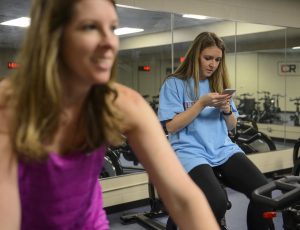
Photo by Thomas Graning/Ole Miss Communications
That notification ping from a new email on your phone while you lie in bed isn’t just another work matter you feel obligated to respond to after hours.
It’s also a contributing factor to increased “anticipatory stress,” which is causing burnout and harming productivity and work-life balance for employees around the country, new research has shown.
A federal labor law that was scheduled to take effect in November but is on hold reclassified many university employees as hourly, which gives those employees the right to “disconnect” when not on duty.
Salaried workers are also encouraged by the Human Resources department to take steps to unplug when possible. Many supervisors and employees on campus are reaping the benefits of time to disconnect.
“I try not to use email after hours and on weekends, and I encourage those who report to me to do the same,” said Leslie Banahan, assistant vice chancellor for student success and wellness. “If there is an emergency or an issue that needs immediate attention or response, we call or text. After-hours emails do not require immediate responses and can wait until the next workday.”
Banahan has worked for decades in higher education, including the time before email existed. She said this helped her understand that the strain on workers caused by 24/7 connectivity can actually be worse for productivity than some periods of unresponsiveness.
A study titled “Exhausted but Unable to Disconnect” found that it’s not simply the amount of time spent on work emails, but anticipatory stress and being expected to answer emails at all times also drains employees. The study by researchers at Lehigh University, Virginia Tech and Colorado State University was presented in August at the annual meeting of the Academy of Management.
Information from 297 workers was sampled, focusing on the role of their employer’s expectation for after-hours emailing. They concluded employees’ emotional states are negatively affected, which can lead to “burnout” and harm to work-family balance.
“Email is notoriously known to be the impediment of the recovery process,” the study’s authors wrote. “Its accessibility contributes to experience of work overload since it allows employees to engage in work as if they never left the workspace and, at the same time, inhibits their ability to psychologically detach from work-related issues via continuous connectivity.”
The proposed federal labor law is in part designed to improve work-life balance for employees.
Hourly employees should completely disengage from work outside business hours. Some exceptions apply, however. A supervisor may require workers to be on call or participate in activities that require the need for response. However, without prior approval from the supervisor, employees who are paid hourly should not respond to email or text messages outside the normal workday.
Employees’ time spent responding to work emails after the workday should be documented because employees may receive compensation for that time. New university time sheet protocols say hourly workers’ time should be recorded in quarter-hour increments, and, for example, eight minutes or less is rounded down and eight minutes or more is rounded up.
The university has also taken steps to improve work life on campus.
UM leaders created the UM 2020 strategic plan with specific wellness objectives. They included developing and implementing a multiyear plan for promoting and advancing health, nutrition, exercise and individual wellness among all workers.
The university’s leadership has also made changes to two employee policies in 2015 to promote a healthier work environment. Department heads are allowed to be flexible with scheduling to let employees participate in physical activity and UM wellness programs.
With the department heads’ approval, employees are also allowed to take two breaks, up to 20 minutes each day. These breaks are designed to encourage workers to stretch, walk or take short bike rides around campus, which can benefit work performance and individual health. These breaks are crucial for “disconnecting” and recharging, employees said.
But, completely unplugging isn’t always easy to do, said Jessica Hughes, a UM human resources generalist. She admits she loves her iPhone and enjoys the diversion of social media when not working.
“I think it’s something everyone in today’s society struggles with – finding the right balance between social media and disconnecting,” Hughes said. “The idea of always being available has made unplugging that much more difficult.”
Hughes said taking a workout session led by an instructor forces her to unplug, and she tries to use the “do not disturb” feature on her phone when she needs some time to herself.
“Going to a workout class led by an instructor forces you to be 100 percent in the moment with your workout, so you really zone out for an hour and have 60 or so minutes of ‘no screen’ time,” Hughes said.
Jill Layne, a senior accountant at the university, has two young children, which leaves her with very little personal time, except daily lunch breaks. She either runs or takes group fitness classes at the Turner Center to de-stress and unplug.
“I have learned that by taking this break during the middle of the day, it has allowed me to recharge,” Layne said. “I may have a crazy morning where I can’t seem to get anything done. If I step away and leave it for a while and clear my head, I can usually come back and turn the day into a productive one.”
She said she’s in the best shape of her life and doesn’t get sick very often, partly because of her wellness efforts. She has also become friends with employees from many different campus departments whom she might not have ever met without the classes.
Judy Hopper, UM’s manager of compensation and classification in HR, said salaried employees should consider taking their lunch away from their work space, which can help remove the temptation to answer the phone or an email.
“It’s OK,” Hopper said. “Give yourself permission for periods of complete disengagement.”